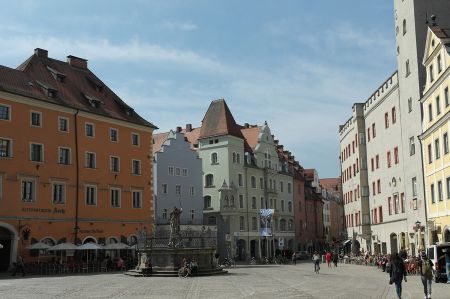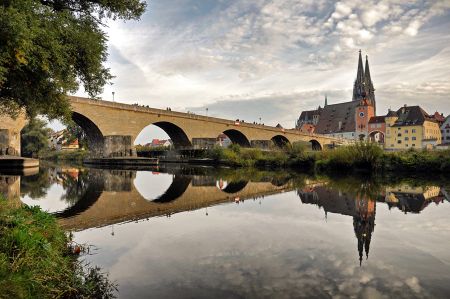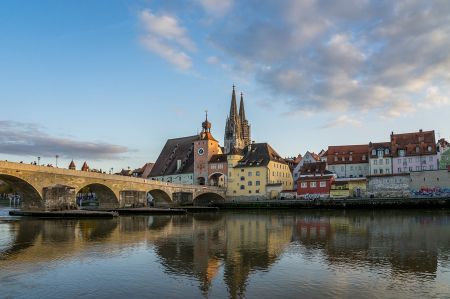We got to know Chris better during the German-Turkish Friendship Festival in Izmir, after he had performed in place of the bassist Frank Eberspächter of the group Backdoor Connection.
We quickly became engrossed in interesting conversations that also addressed his hometown of Regensburg and its Roman past. With regard to our planned project "Understanding and cultural journey along Roman roads" another prominent location that needs to be integrated. So we were delighted when Chris invited us to Regensburg at the end of the concert tour in Izmir in June.
Large car park at the Barmherzige Brüder hospital on Prüfinger Straße
 Now it was finally time to go to Regensburg. The busy A3 drove past Nuremberg into the city center of Regensburg. We had arranged to meet for the first time in his book shop on the Franz von Taxis Ring and "requested" our navigation system to indicate a nearby parking space. So we quickly got to the large parking lot at the Barmherzige Brüder hospital on Prüfinger Straße. For the first time in Regensburg, we then asked an elderly lady for directions to the bookshop.
Now it was finally time to go to Regensburg. The busy A3 drove past Nuremberg into the city center of Regensburg. We had arranged to meet for the first time in his book shop on the Franz von Taxis Ring and "requested" our navigation system to indicate a nearby parking space. So we quickly got to the large parking lot at the Barmherzige Brüder hospital on Prüfinger Straße. For the first time in Regensburg, we then asked an elderly lady for directions to the bookshop.
Very friendly but determined, the lady asked us to get on the bus that was just arriving. The parking ticket also includes the possibility to use public transport and so we quickly reached our destination. We were escorted to the shop door and politely said goodbye. A really nice and helpful person.
Street "Stadtamhof" directly to the stone bridge
 The joy of seeing each other was correspondingly great and Chris was able to free himself for the rest of the day, so that we set off to explore the city at short notice. The sky was gray in grey, but at least it didn't rain. Chris led us on the street "Stadtamhof" directly to the stone bridge, one of the landmarks of Regensburg, which is currently being restored and is therefore only partially accessible to pedestrian traffic. Due to the heavy use by commuters, however, a temporary bridge has also been built. It was probably the gray background of the picture in front of the Stone Bridge, which almost formed a unit with the gray sky over Regensburg and initially irritated us a bit, because it looked as if a tram was coming towards us. Only the people's clothes didn't really fit. Only when you came closer did you recognize the huge poster covering the major bridge renovation construction site.
The joy of seeing each other was correspondingly great and Chris was able to free himself for the rest of the day, so that we set off to explore the city at short notice. The sky was gray in grey, but at least it didn't rain. Chris led us on the street "Stadtamhof" directly to the stone bridge, one of the landmarks of Regensburg, which is currently being restored and is therefore only partially accessible to pedestrian traffic. Due to the heavy use by commuters, however, a temporary bridge has also been built. It was probably the gray background of the picture in front of the Stone Bridge, which almost formed a unit with the gray sky over Regensburg and initially irritated us a bit, because it looked as if a tram was coming towards us. Only the people's clothes didn't really fit. Only when you came closer did you recognize the huge poster covering the major bridge renovation construction site.
The Stone Bridge with its imposing bridge tower was built between 1135 and 1146. It is regarded as a model for the Charles Bridge in Prague and is one of the most important bridge structures of the Middle Ages. Emperor Friedrich I. Barbarossa set out here in May 1189 with his large army on the 3rd Crusade. The bridge tower at the southern end of the bridge was an important part of Regensburg's city fortifications in the past. The bridge tower, also known as the debtor's tower, is the last of what used to be three defense towers on the Stone Bridge. In the past, debtors were often locked up here, who literally had to "catch up" with their debts - using a rod similar to a fishing rod or a string that they lowered from the tower window to beg for a coin or two. The guard lived in a small tower house consisting of two small rooms and a kitchen on the upper floor. The medieval gate tower dates back to the 14th century, and access to the old town and the cathedral was controlled here.
The Salzstadel is located right next to the gate tower, i.e. directly on the Danube. The Salzstadel at the Steinerne Brücke was built between 1616 and 1620.
It was built to store salt, which was unloaded from ships with cranes after the salt trade returned to the city of Regensburg in 1614 after 21 years under the control of the Duchy of Bavaria.
These storage buildings are typical of medieval trading cities, including Regensburg. The construction of the Salzstadel is related to the salt trade, which experienced a great boom in the late Middle Ages; hence most of the surviving warehouse buildings for the hall, as it was called in German, date from this period.
Due to the great value that salt had at that time, trading in the "white gold" was subject to strict regulations.
Archway to the right of the bridge tower
The condition for the sale was the granting of the so-called salt rack by the emperor, which was generally given to individual cities or aristocratic rulers. The buildings intended for central storage and sale were in a convenient location, for example near navigable rivers or main roads through which the salt mined in the Alpine region was delivered. The salt barns along the former salt roads are particularly common. Today, since Regensburg is also a UNESCO World Heritage Site, the visitor center is located in the Salzstadel building. The large archway to the right of the bridge tower was only built in the 20th century because the tram was supposed to pass through here.
The longer we are on the road together, the more we learn to appreciate the detailed knowledge of our "city guide" Chris. A note here, a little anecdote there. We also learn a lot about the historical past, which began well before the Middle Ages. Regensburg is one of the oldest cities in Germany, as the changing names of the city alone indicate. Around 770 AD Radaspona is mentioned in the literature by Arbeo von Freising, a name that can probably be traced back to a Celtic designation: rate or ratis meaning "wall" or "city wall", bona meaning "foundation". . High-quality grave goods from Celtic graves, which were found in early 2006 about 100 meters east of the remains of the Roman legionary camp, date from around 400 BC.
Porta praetoria and Kumpfmühl Castle
The Roman history of Regensburg begins with the establishment of a cohort fort around 79 AD in what is now the district of Kumpfmühl in the course of the Roman occupations up to the Danube. The camp served as an observation post for the mouths of the Naab and Regen and was initially secured by ditches and palisades, later in the Trajanic-early Hadrian period the fort was additionally secured by stone walls. Auxiliary troops were stationed in the camp, either a cavalry cohort of around 500 men or a double cohort of foot soldiers of around 1000 men. During a second stone building period in the late 120s or 130s the camp was expanded from 2.1 to 2.8 hectares. Soon a civilian settlement called "vicus" developed around the fort. A Danube settlement in the area of today's western old town is also suspected for this time. The remains of a Roman observation tower were found near the mouth of the Naab, and the oldest Roman brewery north of the Alps is also believed to have dated from this period (today the Roman pavilion on the Kornweg), but nothing has been found so far. The fort and the civilian settlement were destroyed during the Marcomannic invasion in the second half of the 160s.
As the next highlight of our city tour, we stop at the Dampfnudel Uli at the Watmarkt. On the way there, Chris gets enthusiastic and reports on the Regensburg original, who has mastered the art of baking steamed noodles like no other. Uli is long past retirement age. According to Chris, he is also often not very precise with the opening times, despite or perhaps because of the announcement of his activities on the Internet:
open from Wednesday to Friday 10.01 - 18.01 and on Saturday from 10.01 - 15.01.
And once the steamed noodles are gone, it will be closed.
So Uli must be something special. And indeed, the ambiance alone is worth the visit. A small restaurant in the vaulted cellar, where you can hardly see any brickwork anymore, so all the walls are covered with accessories and pictures of former guests, whose names range from high-ranking politicians to world-famous film stars. Of course we also choose the Dampfnudeln as a dish and truly .... a poem. As Alfred Schubeck once said: "Uli has the best steamed dumplings".
After the steamed dumplings, our city tour should continue quickly, because Chris has chosen the Roman city gate Porta Pretoria as his next destination. The Romans called the main gate of the fort in their military camps porta praetoria. It served as a sally gate and was normally located on the enemy side of the camp. In Regensburg, parts of the Porta praetoria can still be visited today, because the surrounding buildings used what was left of the masonry of the city gate. It can be clearly seen that there must have been a great structural similarity to the "Porta Nigra" sally gate in Trier.
Under Emperor Marc Aurel, the legionary camp Castra Regina (in the German camp near the river Regen) was founded at the mouth of the Regen in response to the Marcomannic Wars around 160 AD and the Legio III Italica was stationed here. She was sent by Emperor Marcus Aurelius around AD 165 along with the Legio II Italica to reinforce the Danube legions when the Roman Empire was at war with both Germania (Marcomanni Wars) and the Parthians. The legion was stationed in Dalmatia until 170 AD and then in Raetia until the middle of the 5th century AD. It had its legion camp in Castra Regina (Regensburg), not in Augsburg, as one might assume, and from this point on it was an essential part of the Rhaetian army, which otherwise consisted of auxiliary troops.
After the Marcomanni had been pushed back until about 170 AD, the legionary camp Castra Regina (camp on the rain) was further expanded by order of Emperor Mark Aurel from about 175. These stone buildings with their approximately 10 meter high protective wall, the four gates and numerous towers are still clearly recognizable in the layout of Regensburg's old town. The stone inscription from its inauguration in 179 AD, which was once located above the east gate and is considered the founding document of Regensburg, is still preserved today. The Legio III Italica was stationed in the camp with around 6000 soldiers. It was the main military base of the province of Raetia and was therefore an exception in the Roman administrative system, as the legion was not stationed in the provincial capital of Augsburg. During the turmoil of the migration of peoples, the fort was given up for military use in the course of the 5th century, and from then on it was a walled civilian settlement.
The city of Regensburg developed from the legionary camp. In 932 this gate was known as Porta Aquarum. When the via praetoria was built over in the High Middle Ages, the gate disappeared from consciousness. The gate was included in the construction of the bishop's courtyard, although parts of the gate system were also destroyed. In 1885 the system was discovered and in 1887 the state that is now visible was restored. The top part of the corner tower, painted white and visible in the picture, is currently used as a hotel room. Significant other parts of the Roman portal are currently buried invisibly in the ground due to the rise in street level.
Our afternoon in Regensburg is already coming to an end and so Chris, who has also arranged to meet his wife in the meantime, has another treat to offer: probably the oldest fast food restaurant in the world, the Wurstkuchl. Located directly next to the Stone Bridge, the building functioned as a construction office during the construction phase between 1135 and 1146. With the completion of the bridge, the small building was quickly converted into a food stall and was henceforth called "Food stall on the crane". For more than 850 years, the historic Wurstkuchl, which is now family-owned, has been supplying locals and tourists with fresh products every day, which go far beyond the range of legendary sausages that have only been around here since the mid-19th century. So e.g. For example, the mustard and sauerkraut for the sausages from the in-house butcher’s shop are made in the historic Wurstkuchl on Thundorfer Straße.
Despite the ubiquitous smoke from the charcoal grill, we too want to experience the typical ambience and sit down in the really tiny dining room. We are particularly fascinated by the marks of the water levels of the Danube recorded from the last centuries. The Wurstkuchl was repeatedly exposed to severe flooding.
We enjoy our sausages, which are traditionally brought to the table with sauerkraut, homemade mustard and special rolls. A short, albeit extremely interesting tour ends at the Stone Bridge for this time.
Please read as well:
Ralf Schumacher introduces – Robeta Schumacher Edition
Steve Hackett with orchestra and choir - "Musical Box"


